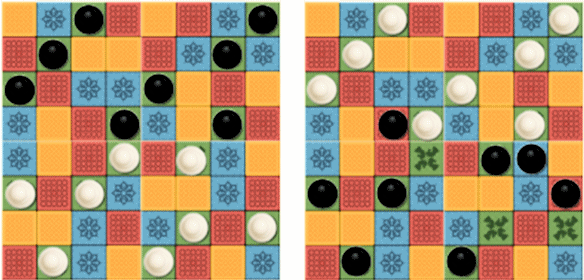
(Published by Huch under the title All Change, probably because few Germans would know the English name of this delicious fruit. Google Translate doesn't even give a German equivalent, but my dictionary offers Reneklode or Reineclaude.)
Start. Place your eight pawns on all the green squares in your half of the board. (First pic.)
Object. To be the first to get all your pawns occupying the eight green squares in the opposite half of the board. (Second pic.)
Play. Normal Katarenga rules of movement apply. If an opposing pawn is occupying a green square that you can land on in your top half of the board you may land on it. Your opponent must then move it, and this counts as their next turn. If it has no legal move, you may reposition it on any square you choose. (This procedure is called ousting and you should say “Oust!” upon initiating it.)
Game. Play ceases as soon as one player has achieved the objective.
Match play. Score 1 point for each pawn your opponent has failed to get home, and play up to an agreed number of points, with the turn to move first alternating.
Variant: Chameleon
You can, of course, specify different colours to go to and from – for example, start on all the blues in your half and aim to occupy all the yellows in your opponent’s half. This gives you 16 different possible games (each colour to itself, and each one to and from every other colour). Red to red, however, is not recommended, as you'll soon see if you try it.
Reminder

Pawns move from red like a rook, from yellow like a bishop, from green like a knight, from blue like a king and not beyond the next square of the colour it started from. It may not jump or land on another pawn except to capture one of the opponent's.

